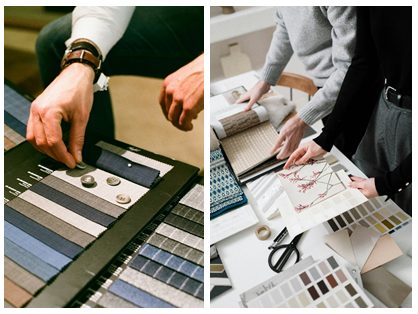Choosing the right fabrics and trims is one of the most crucial steps in fashion design. It’s the moment when creative concepts transition from abstract ideas on a mood board to tangible, wearable garments. The right material enhances the structure, feel, and longevity of a piece, while the wrong choice can compromise the entire design. Beyond aesthetics, today’s consumers are looking for durability, comfort, and sustainability—meaning that fabric selection isn’t just a creative decision but also a strategic one that defines your brand’s identity and market positioning.
The Importance of Proper Material Selection
An outstanding design begins with the choice of quality materials. An unsuitable fabric can compromise the durability and appearance of the garment, affecting your brand’s perception. Moreover, the growing demand for sustainable fashion makes opting for eco-friendly materials a strategic key decision.
Key Factors in Choosing Fabrics
When selecting materials, consider the following aspects:
- Texture and Drape: Assess how the fabric feels to the touch and its movement behaviour. A material with the right texture and drape will enhance the design and ensure user comfort.
- Durability and Maintenance: Analyse the fabric’s resistance to wear and the care it requires. Durable, easy-to-maintain materials increase the garment’s lifespan and customer satisfaction.
- Sustainability: Research the material’s origin and environmental impact. Choosing fabrics with recognised ecological certifications demonstrates a commitment to responsible practices and attracts conscious consumers.
- Design Compatibility: Ensure that the fabric’s colour, pattern, and weight complement and enhance the concept of your collection.
The Role of Trims and Notions
Beyond fabric selection, trims and notions play a crucial role in defining the final look and functionality of a garment. Elements such as buttons, zippers, hooks, ribbons, and decorative embellishments can enhance aesthetics, provide structural support, and ensure practical usability. Just like fabrics, trims should align with your brand’s quality and sustainability standards. Opting for high-quality, responsibly sourced trims not only elevates the design but also contributes to the garment’s durability and appeal. When selecting trims, consider factors like material composition, color coordination, and ease of application to create cohesive, well-crafted pieces.
Adapting the Mood Board Based on Materials
While the mood board serves as a visual guide, it’s essential to remain flexible. Exploring different fabrics may reveal options that better align with your vision or target audience preferences. Being open to these discoveries can enrich and strengthen your collection.
Resources for Finding Quality Materials and Suppliers
To assist in your search for reliable materials and suppliers, here are some valuable resources:
- Directories of Textile Suppliers: Platforms like Panjiva and Tradegood offer extensive databases of companies in the textile sector, enabling you to connect with suppliers that meet your needs. But I love attending Première Vision Paris and TexWorld. At Première Vision Paris, you find suppliers, trends… and at TexWorld, you can find suppliers from all the producing countries. Both fairs are highly recommended.
- Guides on Textile Certifications: Understanding various certifications is crucial to ensure your materials’ sustainability. The OEKO-TEX® certification, for instance, guarantees that textiles are free from harmful substances and are produced in environmentally friendly facilities.
- Trends in Sustainable Textiles: Stay updated on innovations and sustainable practices by consulting resources like Textile Exchange, which promotes the use of recycled and organic materials in textile production.

